
All images © by Roberto Piperno, owner of the domain. Write to romapip@quipo.it.
Notes:
Page added in October 2025.

All images © by Roberto Piperno, owner of the domain. Write to romapip@quipo.it.
Notes:
Page added in October 2025.
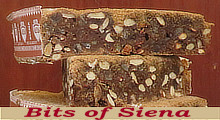 From Porta Camollia to S. Domenico
From Porta Camollia to S. DomenicoThis section is complemented by pages on two Popes from Siena: Pius II and Pius III. They contain images and text related to some monuments of Siena.
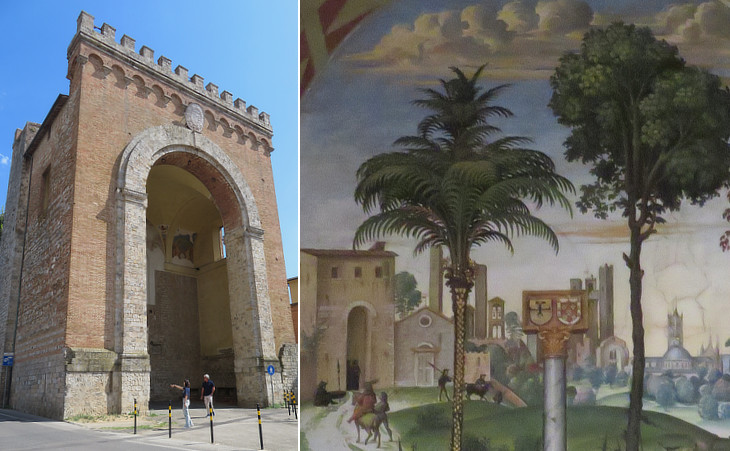
(left) Antiporto (an additional XIIIth century external gate) di Porta Camollia; (right) detail of a fresco by Pinturicchio at Libreria Piccolomini showing Siena from Porta Camollia to the Cathedral
We rode eighteene miles to Sienna,
through most pleasant Hilles, and a fertile Plaine of Corne,
with store of Vines on each side, and many Pallaces of
Gentlemen, (so they call their houses, built of Free-stone,
with a low roofe, and small magnificence), and most
frequent dwellings of husbandmen. We came to Sienna
the Friday before Easter day, and in a publike Inne each
man paied three reali for his Supper. (..) The situation of Sienna is most pleasant, upon a high
hill, and the forme not unlike to an earthen vessell, broad
in the bottom, and narrow at the mouth, which narrow
part lies towards the West, where comming from
Florence, you enter by the Gate Camolia. Neere the
same is a Fort, wherein the great Duke keepes souldiers.
Fynes Moryson - An Itinerary: Containing His Ten Years Travel Through .. Italy (in 1594)
Rome, April 2, N. S. 1740. This is the third day since we came to Rome, but the first hour I have had to write to you in. The journey from Florence cost us four days, one of which was spent at
Sienna, an agreeable, clean, old city, of no great magnificence or extent; but in a fine situation, and good air. (..) The sight of the Duomo and some collections that were shewed us in private houses, were a sufficient employment for the little time we were to pass there.
Thomas Gray - Letters from France and Italy in 1739-1741
Siena is located along Via Francigena (ancient Via Cassia), the main road leading to Rome from the Alps, thus it was visited by many travellers and pilgrims en route to Rome.
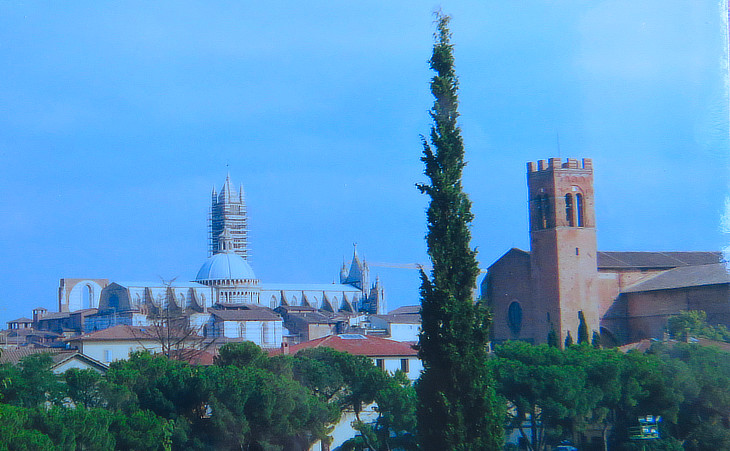
A view of the Cathedral and of S. Domenico from Via di Porta Camollia
November 1644. We walked to the Sapienza, which is the University: (..) indeed this place has produced many excellent scholars, besides those three Popes, Alexander III., Pius II., and III., of that name, the learned Aeneas Sylvius; and both were of the ancient house of the Piccolomini. The chief street is called Strada Romana (aka Banchi di Sotto), in which Pius II. has built a most stately Palace of square stone with an incomparable portico joining near to it. The town is commanded by a castle which hath four bastions and a garrison of soldiers. Near it is a list (la Lizza) to ride horses in, much frequented by the gallants in summer.
John Evelyn - Diary and Correspondence related to his stay in Italy in 1644
We had the prospect of Siena about 10 miles before we came at it. Siena is a fair City, some 4 miles in compass. (..) All the streets and Piazza are paved with brick set edgeways, after the manner of Venice. The whole Town is well built and situate upon a hill and by that means always clean. They heer make no use of snow or ice to cool or refresh their Wines, their cellars keeping it cool enough.
John Ray - Observations topographical, moral, and physiological: published in 1673.
"Cor magis tibi Sena pandit" (Siena shows a heart that is bigger than this gate). Such is the inscription on the Camulia or Florentine gate, where you enter a long, irregular street which nearly bisects this ill-built and ill-peopled town. In this master-line you see none of the principal objects, such as the Lizza, the citadel, the cathedral, the Piazza del Campo; but you see men, you see groups proportioned to the extent of Siena. Leave this line and you pass into a desert.
Joseph Forsyth - Remarks on Antiquities, Arts, and Letters in Italy in 1802-1803
The long street which crosses Siena from Porta Camollia to near the Cathedral is divided into three main sections: Via di Porta Camollia (downhill), Banchi di Sopra (roughly "Upper Shops" downhill) and Via di Città (uphill). Banchi di Sotto (Lower Shops) leads to Porta Romana.
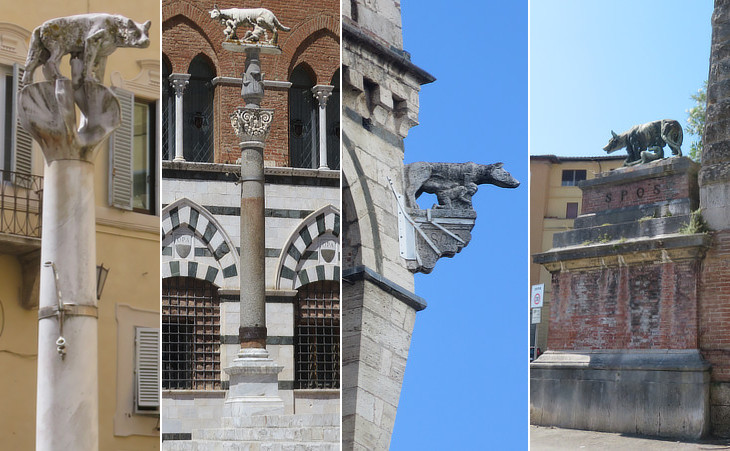
She-wolf suckling two babies in various points of the town: at Piazza Postierla, opposite the Cathedral, at Torre del Mangia and at Barriera S. Lorenzo
This Town is seated in a very wholesome aire and soyl, and therefore much frequented by strangers. Its called Sena in Latin, from the Senones, people of Gaul, who coming into Italy with Brennus, built this town. The streets are all paved with bricks set up edgeway, which makes the Town alwayes dry and neat. Its built high and low, with many high Towers in it, built anciently, in honour of its well deserving citizens, who had done some special service in the Republic and this makes it seen thirty miles off on Rome's side. The people here are very civil, and even sociable too, which together with the good air, the good exercises for gentlemen, the good language , and the great priviledges, make many strangers draw bridle here.
Richard Lassels - The Voyage of Italy, or a Compleat Journey through Italy in ca 1668
Sienna is a city of Italy, in the dutchy of Tuscany, and capital of the Siennese. This city is called Sienna Julia in the itinerary, and by some is confounded with the other colony on the Adriatic called Senigaglia. For its arms it has a she-wolf suckling Romulus and Remus, an argument of its having been a Roman colony. It is situated in a very good air, on an uneven ground, which renders it somewhat inconvenient for walking. The town is surrounded with a wall, and fifteen or twenty square towers; and has a citadel built on a hill.
Thomas Nugent - The Grand Tour - 1749
The citizens of Siena claimed that their city was founded by Aschio and Senio, two sons of Remus, the brother of Romulus, the mythical founder of Rome. Fearing that their uncle wanted to kill them, Aschio and Senio escaped into Tuscany where they founded Siena carrying with them a statue of the she-wolf, the symbol of Rome; this explains why a she-wolf with two children became the symbol of the town.
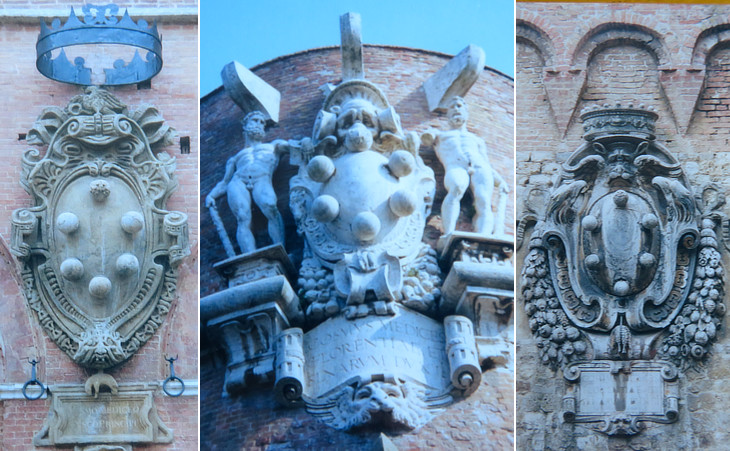
Coats of arms of Cosimo de Medici in Siena (all with the Collar of the Golden Fleece): (left) at Palazzo Pubblico "Cosmo
Mediceo Tusco Principi" (1560); (centre) at Fortezza di S. Barbara "Cosmus Medices Florentiae et Senarum Dux" (1561); (right) at Porta Romana same inscription (1561); see another coat of arms of Cosimo at Massa, a town which belonged to Siena
We came at Dinner to Siena. This is the second Town of the Florentine State. It was heretofore a powerful Republic commanding threescore miles into the Country, and now and then beating the Florentins: but at last, after much strugling, this Woolf received the muzzle, and Siena is now the humble servant of Florence. This happened Anno 1555. Lassels
As this is the last republic that fell under the subjection of the Duke of Florence, so it is still supposed to retain many hankerings after its ancient liberty. For this reason, when the keys and pageants of the Duke's towns and governments pass in procession before him, on St. John Baptist's day, I was told that Sienna comes in the rear of his dominions, and is pushed forward by those that follow, to show the reluctancy it has to appear in such a solemnity.
Joseph Addison - Remarks on several parts of Italy, in the years 1701, 1702, 1703
For several ages it was a free city, and the head of a republic, till taken by Charles V. and sold to the duke of Florence. 'Tis now the third city in the country, and the seat of an archbishop. Nugent
Sienna and Pisa could once count each a hundred thousand inhabitants, and though their territories scarce extended ten miles around their walls, yet their opulence enabled them to erect edifices that would do honor to the richest monarchies. These cities yielded in time to the prevailing influence of their rival Florence; and under its Dukes they withered away into secondary towns; while their wide circumference, stately streets, and marble edifices daily remind the few scattered inabitants, of the greatness and of the glory of their ancestors.
John Chetwood Eustace - Classical Tour of Italy in 1802 (publ. 1813)
On October 18, 1560 Cosimo, Duke of Florence, made his entrance in Siena at Porta Camollia. Initially he was the ruler of two separate dukedoms: Florence and Siena, but in 1569 he managed to be appointed Grand Duke of Tuscany by Pope Pius V. The capital of the new state and the court were set at Florence. Siena retained a formal autonomy (Stato Nuovo di Siena) and some city magistrates, but "de facto" lost its independence.
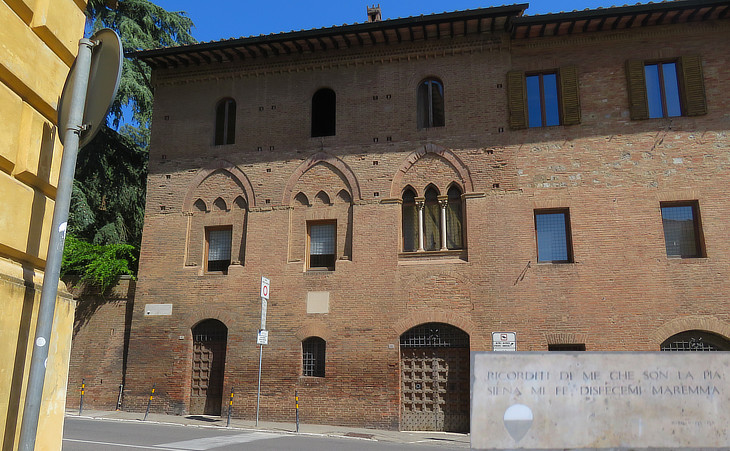
Palazzo della Consuma with an inscription quoting Dante; (inset) inscription at Palazzo Tolomei: Do thou remember me who am the Pia;
Siena made me, unmade me Maremma; Dante, Purgatorio, Canto V. (there are six other quotations from Dante in the streets of Siena)
Palazzo della Consuma, a XIIth century building near Porta Camollia, is renowned because it housed a group of young and rich citizens who wasted their fortunes in banquets and revelries. Their chief object was to collect a purse of 200,000 ducats, and spend it in twenty months. Their pheasants were roasted with fires made of cloves, and their horses were shod with silver. Dante has perpetuated the memory of these young prodigals in the twenty-ninth chapter of the Inferno: "And taking out the band, among whom squandered
Caccia d'Ascian his vineyards and vast woods. And where his wit the Abbagliato proffered!"
They were not the only ones who did so: (Boswell to Jean Jacques Rousseau. Original in French - August 1765) From Florence I went to Siena, where I passed a portion of my existence in perfect felicity. The nobility there form a society of the most amiable sort. They have a simplicity, an openness, a gaiety which you cannot imagine without having been there. They have no society manners, none of that affected air which to the philosopher betrays artificial beings. You, Sir, as delicate as you are, could live in the society of Siena. Since there is no Court there and the nobles think only of living within their moderate incomes, you never see in Siena those gentlemen with great interest who spoil every company in a city where it is thought that something may be gained by paying court. The Sienese are independent, equal, and content to be so, and when a great prince comes among them he is politely received, but they do not put themselves out for him. (..) Never have I seen so much of what I should call true humanity as at Siena. People there do not embarrass a stranger by giving him a studied reception. (..) I had excellent apartments at Siena. I ate well. The wine of the
district was very good, and on holidays I regaled myself with delicious Montepulciano. The air is fresh, and the weather is always
fine. My health was very quickly restored. An Abbe of talent and
obliging disposition dined with me every day, and accommodated
himself perfectly to the little variations of my temperament. He
helped me as teacher in Italian. Every morning for two hours I read
the divine Ariosto, and you can imagine the effect which that produced on my romantic soul. I also wrote in Italian with equal regularity, and as I used no other language in conversation, I made rapid
progress. The Sienese dialect is the most agreeable in all of Italy. For
me it was a continual melody. I had lively sensations of pleasure
when I heard people merely discussing the good weather. (..) 5 September 1765. I have been a week in Siena and have not as yet seen any maraviglia as the Italians say. I should not be able to say why to any one who demanded a proper reason, but I can explain it very well to myself: it is because I have been so busy with women that I have felt no curiosity about inanimate objects.
James Boswell's letters on the Grand Tour.
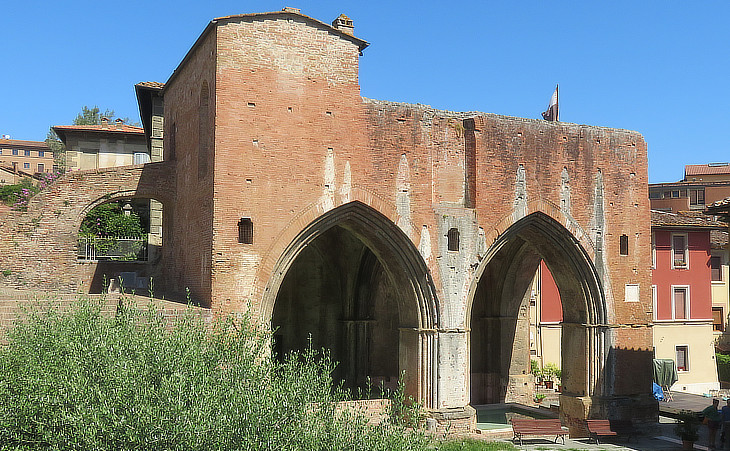
Fonte Nuova (off Via di Porta Camollia)
There are divers other public fountains in the city, of good design. Evelyn
Near the Piccolomini Palace is the Fonte di Fullonica, begun in 1249, and presented to the city by the native architect Francesco di Giorgio in 1489. The Fonte Nuova, built in 1259, is another remarkable work. (..) Of the numerous Oratories, the most interesting are those occupying the house of St. Catherine of Siena, and the ancient Fullonica of her father, who was a dyer and fuller.
John Murray - Handbook for travellers in Central Italy - 1843
The imposing design and size of some fountains of Siena indicates that, similar to the ancient Roman fullonica (see one at Pompeii), they were used for the cleaning and dyeing of wool clothes.
Similar fountains were built at Massa and Volterra.
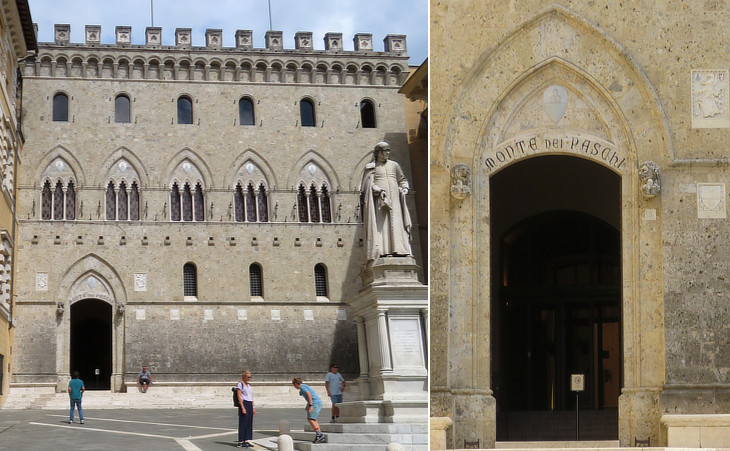
Palazzo Salimbeni, Headquarters of Monte dei Paschi (Banchi di Sopra)
(1873) Every thing is cracking, peeling, fading, crumbling, rotting. No young Sienese eyes rest upon anything youthful; they open into a world battered and befouled with long use. Everything has passed its meridian except the brilliant facade of the cathedral, which is being diligently retouched and restored, and a few private palaces whose broad fronts seem to have been lately furbished and polished.
Henry James - Italian Hours - 1909
In the XVth century the building housed the custom house for the travellers and the goods which entered Siena at Porta Camollia and Monte Pio, the local Monte di Pietà, a charitable institution which was instituted as a bank for the poor, who, if the sum was not great, could have money upon pawns. In 1866 it was acquired by Monte dei Paschi, a bank whose depositors were granted the income of the state-owned pastures of Maremma (the so-called "Paschi" which gave the bank its name). The palace was entirely redesigned in neo-Gothic style in 1877 by Giuseppe Partini. It is not the only building which was given the appearance of a typical XVth century palace.
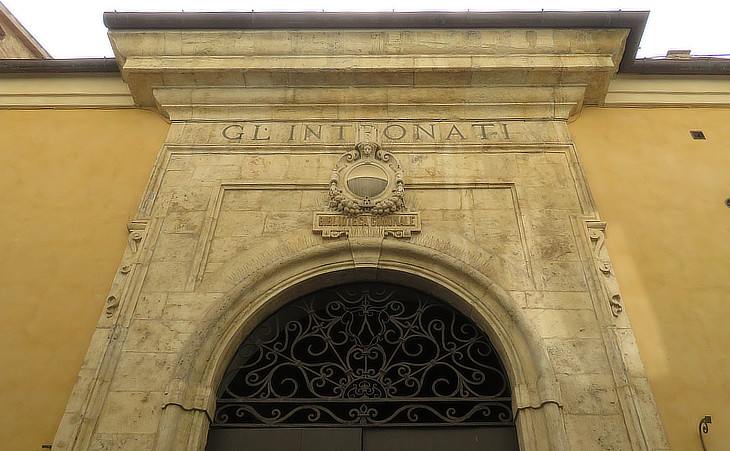
Portal of Accademia degli Intronati off Banchi di Sopra near Monte dei Paschi
I saw here the Academy of wits called degli Intronati: why they should take that ambitious name I know not. Lassels
A solemn accademia was then held by the Intronati who recited several dozens of fresh sonnets on the assumption of the Blessed Virgin. On this holy theme have those prolific academicians been rhyming for three hundred years.(..) The Intronati of Siena are generally considered as the oldest academy in Europe; yet the Rozzi of this city, if they were really associated for literary pursuits, (as some of their own body have assured me) were anterior to the Intronati, and even to the club of Platonists whom old Cosimo de' Medici collected round him. Such is the passion here for academies, that the noble college Tolomei has formed three out of fifty students. So early as the 16th century Siena counted 16 academies. In the following age a female one was founded here by the Grand Duchess Vittoria d' Urbino but this did not long survive its foundress! Forsyth
The bizarre name of the Academy (today we would say Rintronati) meant that its members wanted to detach themselves from the noise of the ordinary world which deafened them.
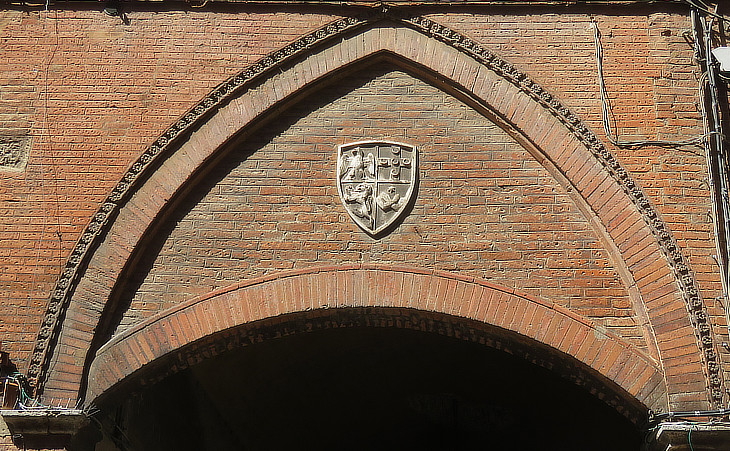
Arco dei Pontani (Banchi di Sopra)
All the pavement of the streets is of bricke, which lasteth the longer, because there be neither carts nor coaches, but all burthens are carried upon the backes of Asses. Fynes Moryson
The streets are paved with tiles laid in that fishbone manner which Pliny calls the "Spicata testacea". A stranger coming from the large flat stones of Florence feels the transition unpleasant; but the extreme inequality of the ground, which is covered with ice in winter, would render the Florentine pavement unsafe for Siena. Every gentleman's house is called by the courtesy of the place a palace, although few of them include courts, which, in most languages, are the very part of a house that qualifies a palace. Some of those old mansions are built in the mixt, demigothic style which marks all the public works of their two great architects Agostino and Agnolo. The windows are beset with an awkward angular fret-work which I have not observed elsewhere. Forsyth
The Palaces of Siena are more remarkable as examples of the domestic architecture of the middle ages, than for the works of art which they contain. They present almost every variety of simple and compound Gothic style. (..) The Palazzo Buonsignori is a fine example of Gothic, with a terra-cotta front. Murray
The use of bricks characterized not only the streets of Siena, but also its palaces. The Pontani were a family from Umbria who lived in the building in the XVIth century.
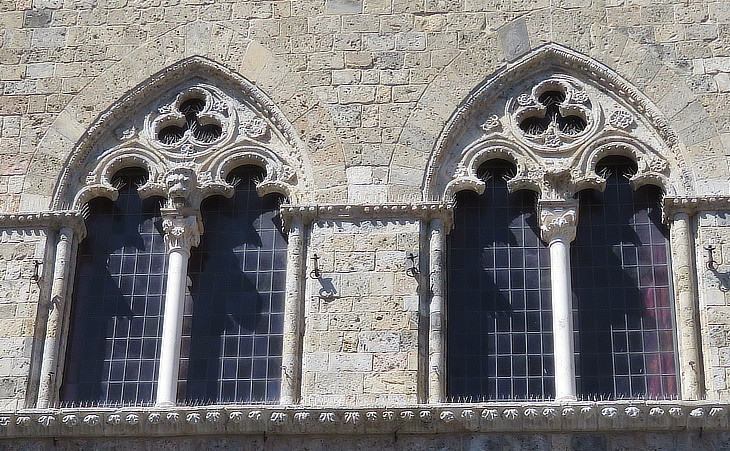
Windows of Palazzo Tolomei (Banchi di Sopra); see the whole palace
(1873) The great private palaces which are the massive majestic syllables, sentences, periods, of the strange message the place addresses to us. They are extraordinarily spacious and numerous, and one wonders what part they can play in the meagre economy of the actual city. (.. ) Many of these dusky piles still bear the names of the old mediaeval magnates. James
The Palazzo Tolomei (1270-75) was not only the private residence of a prominent Sienese family, but was also the first legislative headquarters of the Guelph commune. Its features and ornaments may have served as a model for the initial versions of the Palazzo Pubblico in Siena.
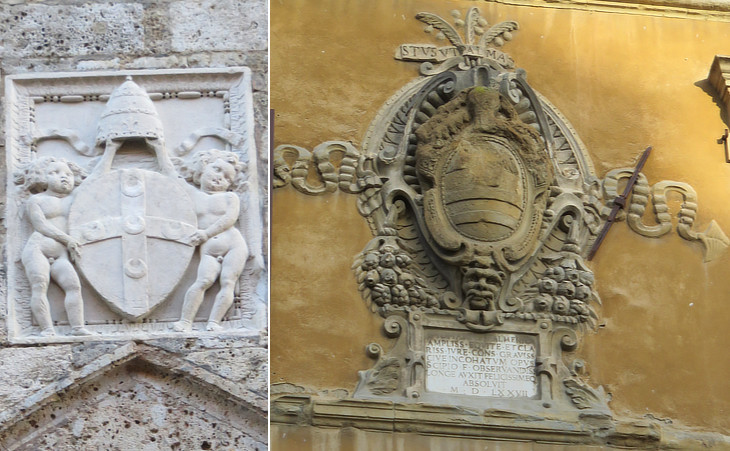
Banchi di Sopra: coats of arms: (left) of Pope Pius II at Palazzo Bichi Ruspoli (the coat of arms of the Pope does not show the keys of St. Peter, which will consistently become part of the papal heraldic symbol only at a later period); (right) at Palazzo Palmieri
Giovanni Palmieri was in charge of defending the castle of Montalto north of Siena, but in 1553 the Spanish troops of Emperor Charles V conquered it. He managed to retain his possessions and established a good relationship with the Medici. He enlarged his palace in Siena and his son Scipione completed the work in 1577. The design of the coat of arms reflects the fashion of the time, in particular the long ribbons which were typical of the coats of arms of Pope Paul III. It is very similar to a coat of arms of the Chigi in Piazza di Postierla.
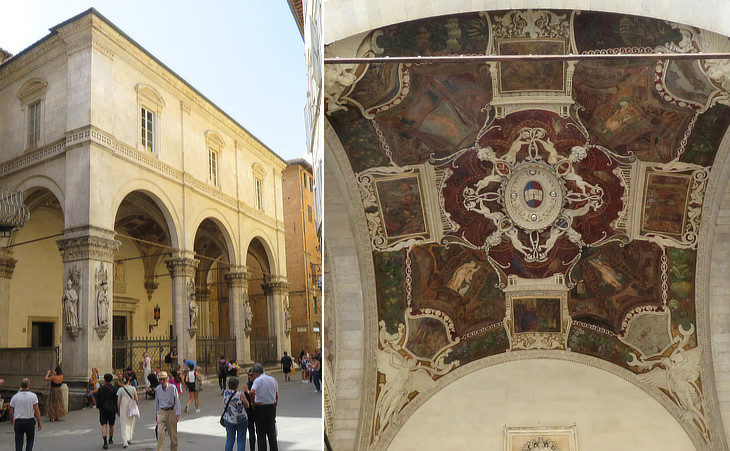
(left) Loggia della Mercanzia and Casino dei Nobili (at the beginning of Via di Città); (right) XVIth century decoration of the ceiling of the loggia
The other principal places, are the college of the nobles, established in 1681. Nugent
The Loggia di San Paolo, built in 1417 by the merchants of the city, and now called the Casino de' Nobili, was remarkable in the middle ages as the most impartial commercial tribunal in Italy; its laws were recognised by nearly all the other republics, and its decisions were considered equally binding.
Murray
The nobility meets at the Casino di Nobili, the club of the best society. It is very numerous and very rich and it is still perfectly feudal and uplifted and separate. Morally and intellectually, behind the walls of its palaces, the fourteenth century, it's thrilling to think, has n't ceased to hang on. There is no bourgeoisie to speak of; immediately after the aristocracy come the poor people, who are very poor indeed. James
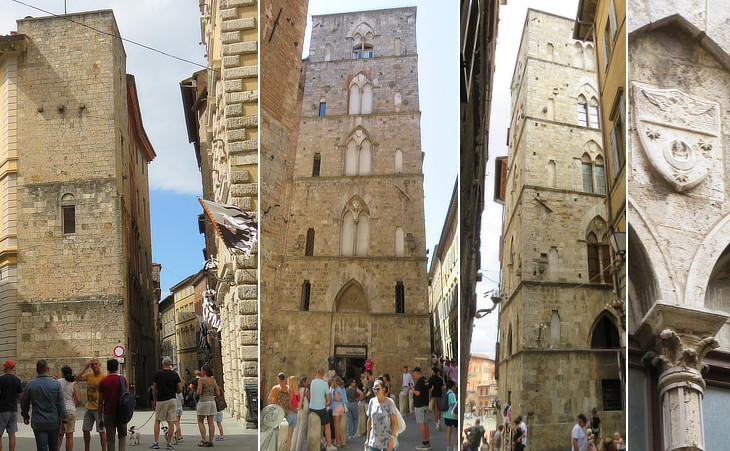
(left) Torre dei Malavolti opposite Palazzo Salimbeni (Banchi di Sopra); (centre/right) Torre delle Sette Seghinelle (XIIIth century), part of Palazzo Crocini or Accarigi (Via di Città - but its terrace enjoys a commanding view over Piazza del Campo)
The street entered at the Porta Camollia, or the Florentine gate, divides the city into two nearly equal portions; the streets are generally narrow and irregular, frequently so steep as to be impassable in carriages, and many of them are mere narrow lanes; they are mostly paved with tiles. The streets are generally bordered with immense mansions called palaces, although they have neither the aspect nor the architectural features of a palace. Many of them have lofty towers, and rings near the entrance, like the old mansions of Florence. Murray
These streets are hardly more than sinuous flagged alleys, into which the huge black houses, between their almost meeting cornices, suffer a meagre light to filter down over roughhewn stone, past windows often of graceful Gothic form, and great pendent iron rings and twisted sockets for torches. James
See the iron rings of Palazzo Piccolomini and the tower houses of Volterra.
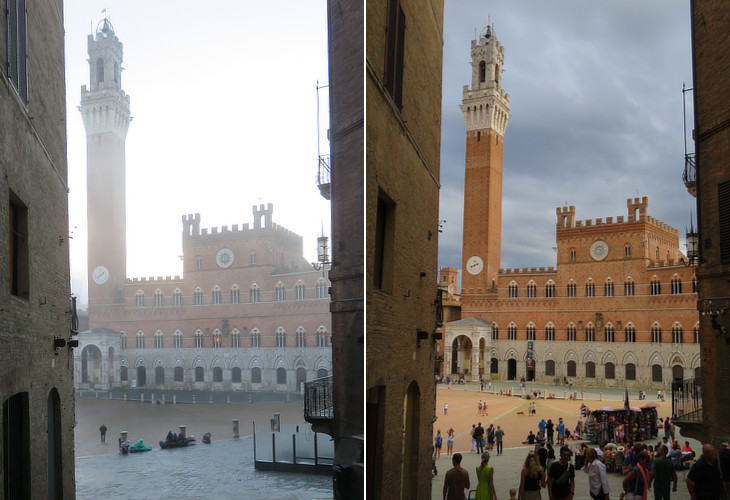
Piazza del Campo from near Palazzo Crocini: (left) early morning in January; (right) midday in August
Sienna stands high, and it is adorned with as great many towers of brick, which in the time of the commonwealth were erected to such of the members as had done any considerable service to their country. These towers gave us a sight of the town a great while before we entered it. (..) I shall speak nothing of the extent of this city, the cleanliness of its streets, nor the beauty of its piazza, which so many travellers have described. Addison
The dusky labyrinth of the streets is interrupted by two great candid spaces: the fan-shaped piazza, and the smaller square in which the cathedral erects its walls of many-coloured marble. (..) On the firm edge of the palace (..) grows a tall slim tower which soars and soars till it has given notice of the city's greatness over the blue mountains that mark the horizon. It rises as slender and straight as a pennoned lance planted on the steelshod toe of a mounted knight, and keeps all to itself in the blue air, far above the changing fashions of the market, the proud consciousness or rare arrogance once built into it. James
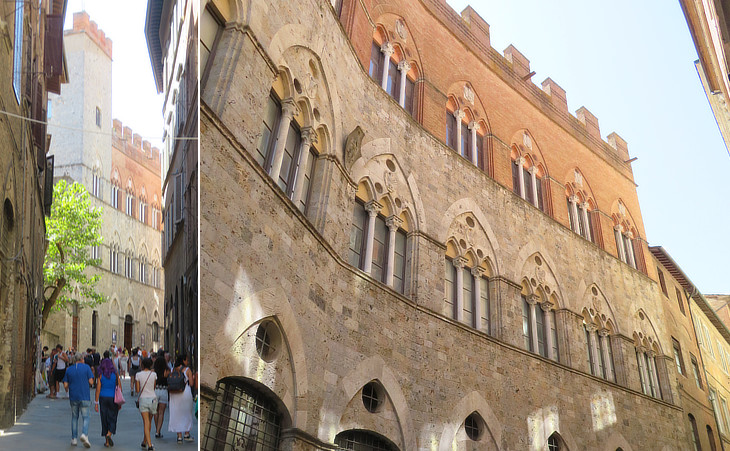
Palazzo Chigi Saracini (Via di Città)
The Palazzo Sarazini has a collection of painters by the Sienese masters, the most interesting of which is the Christ in the Garden, by Sodoma. Murray
The tower was erected in the XIIth century and the adjoining palace is a result of a series of additions. In 1770 it was purchased by the Saracini family, who greatly enlarged it to its present form. Galgano Saracini made it his home, collecting great artistic masterpieces.
In 1806 it was opened to the public and quickly became a private museum. At the end of the XIXth century, the palace was inherited by Fabio Chigi, who added his name to the Saracini. In 1923, the restoration of the palace was completed and a concert association was established, which in 1932 became the Fondazione Accademia Chigiana, still today an important musical school.
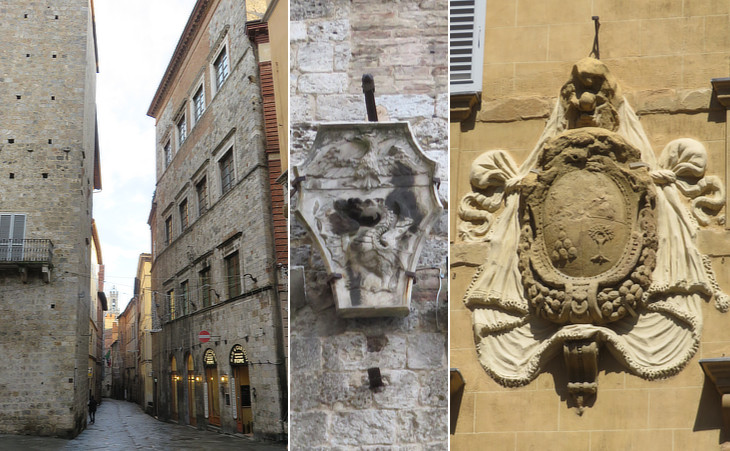
(left/centre) Piazza di Postierla - Via di Città: Palazzo Borghesi and coat of arms of the family; (right) XVIth century coat of arms of the Chigi on a palace in Piazza di Postierla which subsequently was acquired by the Piccolomini Todeschini
1658 - Dec. 23. The next day wee were on horse backe two houres
before day, and dined at an Ancient Citty called Sienna, and in which Citty the Pope
now alive was borne. It is a very fine Citty, large and
populous.
Francis Mortoft - Journal of his travels in France and Italy in 1659
Mortoft made reference to Pope Alexander VII, i.e. Fabio Chigi who promoted several initiatives for the embellishment of the Cathedral and in general of Siena. The Chigi became very rich in the early XVIth century thanks to Agostino Chigi who was the banker of Pope Julius II who allowed him to add his heraldic symbol to the six mountains and the star of his family. The family afterwards declined, but Alexander VII restored its fortunes.
Pope Paul V, i.e. Camillo Borghese descended from a noble family from Siena and is regarded as a pope from Siena, although he was born in Rome. The Borghese ties to Rome began when Marcantonio Borghese I became the ambassador of Siena to the pope. Both the overtake of Siena by the Medici family of Florence and Marcantonio's marriage to a member of a noble Roman family, Flaminia Astalli, established the Borghese as members of the aristocracy of Rome.
A short street leads from Piazza di Postierla to the Cathedral which is covered in a separate page.
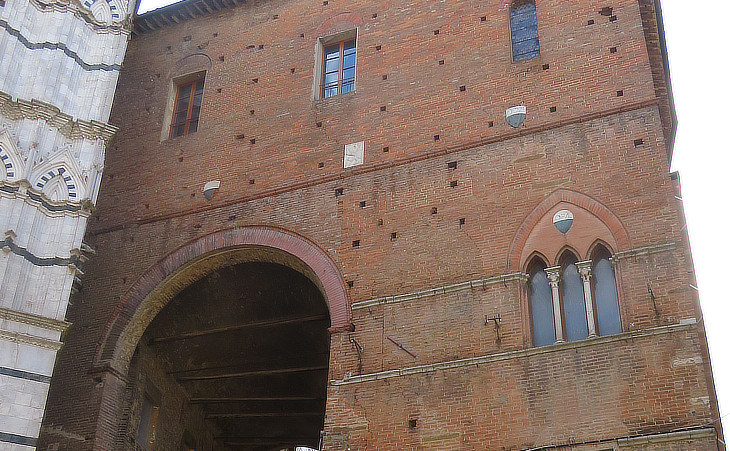
Palazzo del Magnifico at the side of the rear part of the Cathedral
The Palazzo del Magnifico, with its fine bronze ornaments and rings, is remarkable as having been erected in 1504 by Pandolfo Petrucci, the celebrated tyrant of Siena. Murray
The Petrucci were a major family of Siena and held important positions in the government of the Republic. In general they were very hostile to the Medici. Pandolfo Petrucci (1452-1512) in 1487 managed to become Signore (Master / Ruler) of Siena and held this role until his death. At his time the Italian States were confronted with the frequent wars between France and Spain for the hegemony in Italy and with the attempts of Pope Alexander VI (Rodrigo Borgia) to expand the possessions of the Papal State. Pandolfo managed to retain the independence of Siena and for this and for his patronage of the arts he was given the appellation of Il Magnifico, similar to what occurred at Lorenzo de' Medici in Florence.
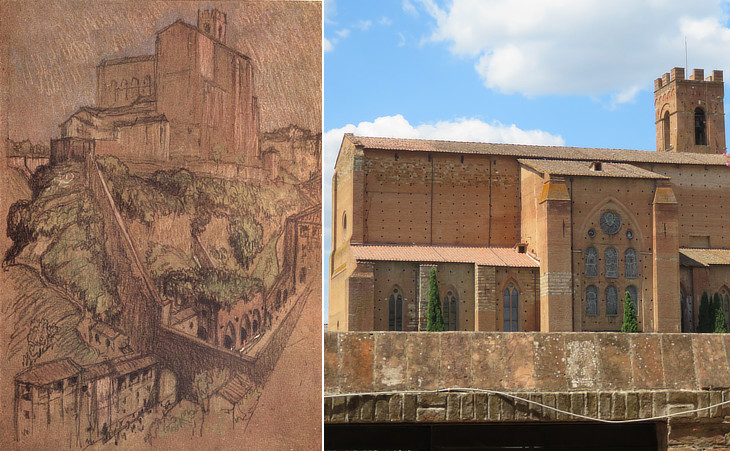
(left) S. Domenico and Fonte Branda, illustration by Joseph Pennel for "Henry James - Italian Hours - 1909"; (right) S. Domenico seen from near the Cathedral
From the Duomo discending by slope and steepe streetes towards the South-west wall, you shall come to a most pleasant Fountaine, called Fonte Branda, without the South gate, of which the Citizens proverbially say, that if a stranger drinke thereof, he shall so love Sienna, as he shall very unwillingly and scarce at all depart from the City. But the Florentines in scorne of the Siennesi, have a proverbe, Chi de fonte Branda beve, diventa pazzo; He that drinkes of the fountaine Branda becomes a foole. It casts out water by nine mouthes of stone, and there be three places where Laundresses wash, and neere the same is a pleasant grove. Fynes Moryson
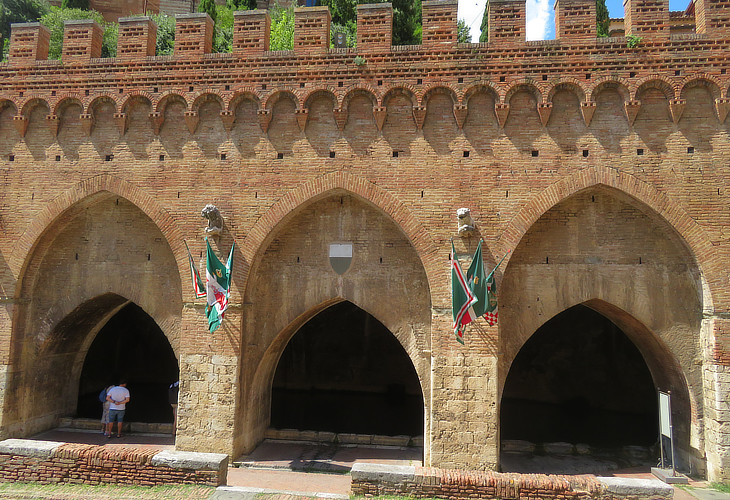
Fonte Branda in the former neighbourhood of the wool-makers; notice the "balzana" the symbol of Siena, a shield split horizontally into white/silver and black sections
Below the hill stands the pool called Fonte Brande, where fish are fed for pleasure more than food. Evelyn
The ancient Gothic Fonte Branda, constructed by Bellamino in 1193 at the command of the consuls of Siena, is immortalised by Dante. (..) It is, however, doubtful whether its position corresponds with the description of the poet. Murray
The Dominican church sustained such a shock from the late earthquake, that it no longer serves for worship, nor contains the celebrated Madonna of Guido da Siena, the first Italian painter whose works bear a date. Hence the Senese pretend, from the date of this picture, 1221, that their school of painting was the earliest in modern art. Forsyth
San Domenico, begun in 1220 and not finished till 1465, is an interesting and imposing edifice, seventy-five feet wide; spanned by a pointed arch of singular boldness, which sustains the transepts, and is well worthy the study of architects. Murray
The church does not have a façade. It is accessed through a simple side entrance.
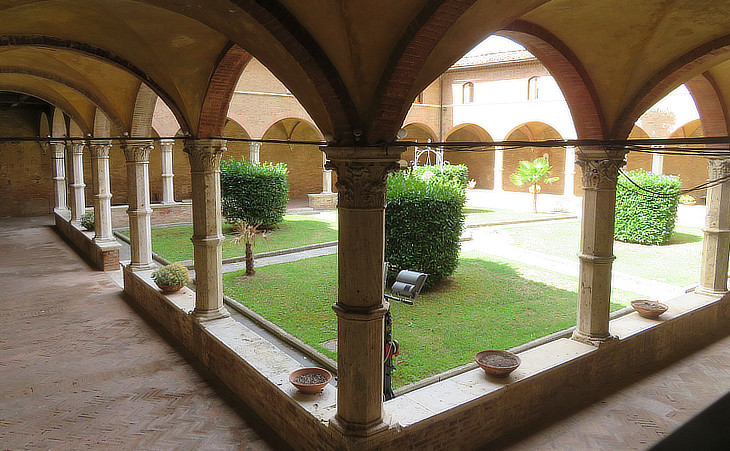
S. Domenico: cloister of the monastery
In the 1780s the Dominicans were forced out from their monastery at Siena by Grand Duke Leopold I as part of a general effort to reform the State in line with the principles of the Enlightenment. He promoted public education and thus he decided to reduce the influence of religious orders in this field. In 1923 a very small community of Dominican monks returned to Siena and since then they are in charge of the monastery and of the church.
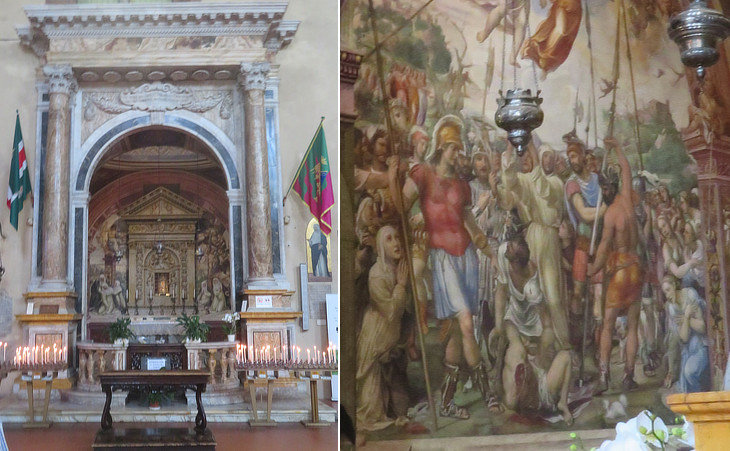
S. Domenico: (left) Cappella di S. Caterina; (right) fresco by il Sodoma on the left wall of the chapel (1520): Catherine prays for the soul of Niccolò di Toldo, whom the saint comforted before his beheading
Not far from the castle is the Church and Convent of the Dominicans, where in the chapel of St. Catherine of Sienna they show her head, the rest of her body being translated to Rome. Evelyn
I saw here the several places which St. Catharine of Siena had made famous by her Devotions: (..) in the Dominicans Church they also shew her head, and finger: her body being transferred to Rome. Lassels
On one side of the altar is the fine picture of St. Catherine fainting in the arms of two nuns at the appearance of the Saviour, by Sodoma; on the other side of the altar is St. Catherine in ecstasy, and the Almighty, with the Madonna and Child, attended by angels, appearing to her. (..) The great festival of Siena is that in honour of St. Catherine. This popular saint was the daughter of a dyer; she was born in 1347, and took the vows when only eight years of age. Her revelations and miracles gained her so high a repute, that she succeeded in inducing Gregory XI. to remove the Holy See from Avignon after it had been fixed there for seventy years. She died in 1380, and was canonised in 1461. Murray
Giovanni Bazzi, il Sodoma (the appellative does not refer to an improper conduct), was an important painter of the early Renaissance in Siena and in Rome where he decorated the bedroom of Agostino Chigi at Villa della Farnesina.
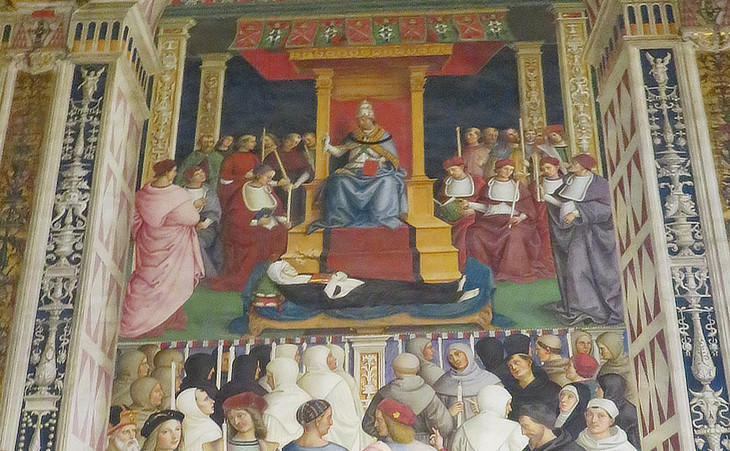
Libreria Piccolomini in the Cathedral: Canonisation of St. Catherine inside S. Domenico by il Pinturicchio
I shall say nothing of the many gross and absurd traditions of St. Catharine of Sienna, who is the great saint of this place. I think there is as much pleasure in hearing a man tell his dreams, as in reading accounts of this nature. A traveller, that thinks them worth his observation, may fill a book with them at every great town in Italy. Addison
Catherine is the only female saint who was canonised in the XVth century and the decision by Pope Pius II was very much influenced by her being a member of the Dominican order and a native of Siena. In his bull he wrote that Catherine had received the stigmata in 1375, but at her request they were not made visible on her body. Pope Sixtus IV, his successor and a Franciscan, forbade painters and sculptors to portray the stigmata. The issue was debated for a long time until the event was formally acknowledged by Pope Urban VIII in 1630 who prescribed that painters should represent the wounds as glowing and not bleeding points, as those in portraits of St. Francis. In 1724 Pope Benedict XIII, a Dominican, established a Feast Day (April 1st) to celebrate the stigmata.
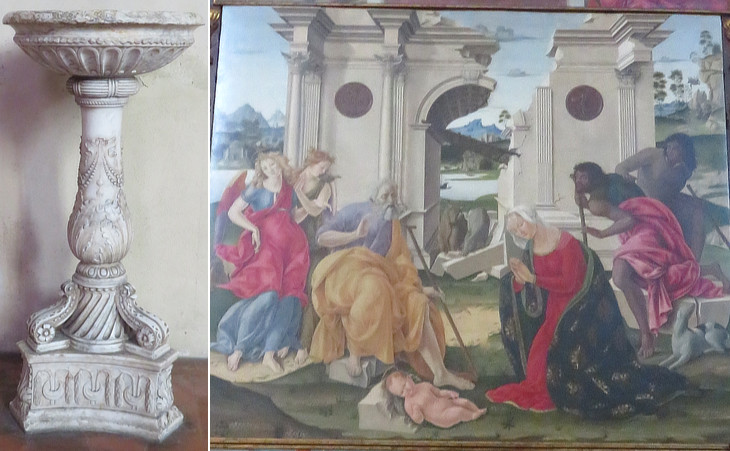
S. Domenico: (left) holy water font; (right) Crib by Francesco di Giorgio Martini (ca 1490)
Francesco di Giorgio Martini (Siena 1439-1501) is best known as an architect and in particular for his activity at Urbino and for the design of fortresses in that duchy (e.g. Sassocorvaro). He was also a talented painter and in his Crib at S. Domenico he shows his knowledge of ancient and Renaissance architecture: the crumbling building calls to mind Tempio Malatestiano at Rimini.
The image used as background for this page shows the heraldic symbol of the Piccolomini (five moons) in Via Banchi di Sopra.
Move to
Piazza del Campo
Cathedral - The Building (to be developed)
Cathedral - Interior (to be developed)
Museo dell'Opera del Duomo (to be developed)
S. Maria della Scala (to be developed)

